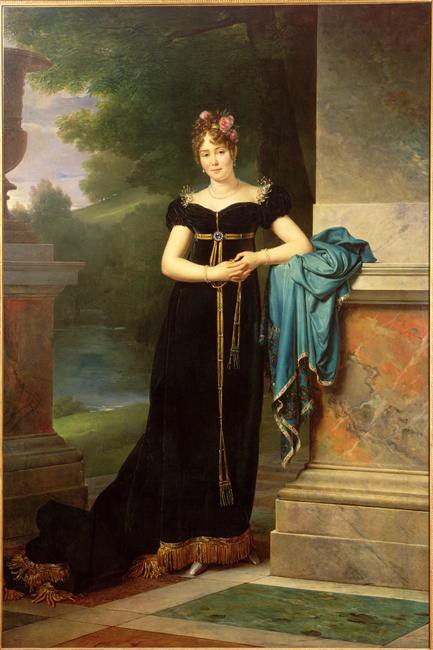When Baron Gérard painted this portrait of the Countess Marie Walewska in 1810, the young lady in question was twenty-three years old, and had been one of Napoleon’s mistresses for the last three years. It is not clear whether the portrait was painted before or after she gave birth to Napoleon’s son, Alexander, Count Walewski, on 4 May 1810. It was this same year that Napoleon married the second French Empress, the nineteen-year-old Marie-Louise, whom Gérard also painted.
If the portrait of Empress Marie-Louise was an official commission from the Emperor, this portrait of Napoleon’s mistress was most likely (and prudently) a private commission, perhaps from the Countess herself. The portrait remained in the family of Marie Walewska’s second husband, Philippe Antoine d’Ornano, throughout the nineteenth century (she had married the Count and General d’Ornano in 1816). The painting was given as a bequest to the Musée de l’Armée in 1986, and hangs in the Ornano Gallery. Only one copy of the work is known – a much smaller version which belonged to Gérard himself and which was acquired by the Château de Versailles in 1837.
This portrait makes use of the neo-classical elements (marble urns and columns, antique drapery…) which made the reputations of the great Empire portraits of David, Gros, Prud’hon and Gérard himself. What separated Gérard from his contemporaries at the imperial court, however, was the speed of his execution: this can be seen in the 1805 portrait of Juliette Récamier, which consolidated Gérard’s reputation, unlike David, who would never complete his portrait of the famous sitter.
Gérard’s originality in his full-length female portraits is to make his sitters look natural in their poses, removing any artificial allure. Far from making her seem rigid, Gérard uses the classical setting – especially the antique column – to give Marie Walewska the nonchalant and elegant pose of a young woman. The Countess has casually placed her shawl on the ledge next to her, and playfully toys with the ribbon of her belt. Everything is conceived in this canvas to give the impression that the painter has jotted the composition down in an instant as his subject returned from a walk in a garden.
Marie Walewska’s pose is close to that of Madame Tallien, whom Gérard had painted five or six years earlier: she also returns from a summertime stroll, and is about to return indoors. The essential difference between these two portraits is doubtless due to the colour of Marie Walewska’s dress. Unlike the majority of female portraits from the period, whose sitters are dressed in either the antique style, wrapped in pale, light layers, or, in the case of the Bonaparte family, in the imperial colours, Marie Walewska’s Empire-style dress is black. It is certainly elegant, with its fine golden decoration, but does its sombre, discrete tone reflect her position as the Emperor’s “Polish wife”, in the shadows of the imperial couple?
Marie de Bruchard, August 2014 (translated by Francesca Whitlum-Cooper)
View the Musée de l’Armée’s entry on the portrait here (in French).


